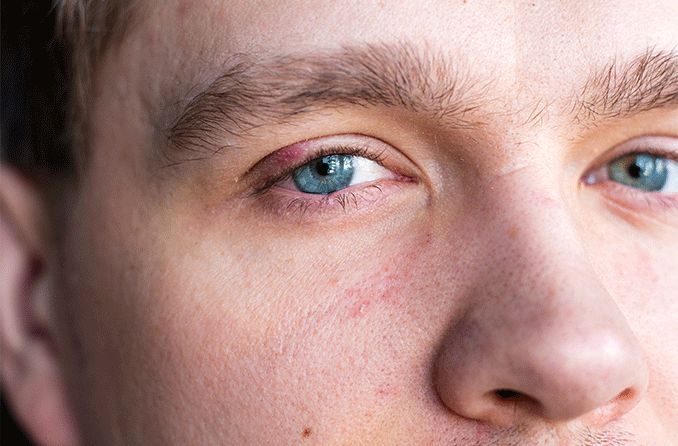How do you get a stye?

A stye is a red, sometimes painful bump that develops on your eyelid, near the base of an eyelash.
So, how do you get a stye, exactly?
Styes are caused by bacteria that get trapped in an eyelash follicle or eyelid glands (called meibomian glands). While this may seem easy enough to avoid, there are certain risk factors to developing a stye that may surprise you.
Eye stye causes
Bacteria called staphylococcus are commonly found on your skin and in your nose and typically don’t cause any problems. However, when this bacteria, along with dead skin cells, get trapped in an oil gland or hair follicle on the eyelid, it can get infected.
This infected gland or follicle results in a red, swollen, painful bump usually located on the outer lash line. The bump, similar to a pimple, is filled with pus and white blood cells that go to work when an infection is detected.
How long a stye lasts, from the time it first develops to the time the eyelid heals, is around seven to 10 days. Typically, the stye is most swollen and irritated for approximately three days, then naturally opens and drains on its own.
It’s important that you do not try to pop the stye yourself. Not only is this painful, but the pressure can injure the eyelid and create a wound that welcomes more infection.
SEE RELATED: Pink eye vs. Stye
Risk factors for developing a stye
Anyone can get a stye, but some individuals are more susceptible to them. Some habits that raise your risk of developing a stye include:

Rubbing or touching your eyes — As mentioned earlier, bacteria naturally live on your skin and in your nose. However, your fingers and hands are a hotspot for germs, so touching your face and eyes, especially with unwashed hands, raises your risk of developing a stye, conjunctivitis and other infections.
Using expired or contaminated eye makeup — Mascara and other eye makeup, especially when used daily, are breeding grounds for bacteria. If using expired makeup isn’t risky enough, sharing eye makeup with another person significantly increases your chances of developing an eye infection.
Wearing contaminated contact lenses — Putting on contact lenses that haven’t been cleaned, or applying them with unwashed fingers, makes the eyes susceptible to bacteria. Be sure to wash your hands and clean and store your contact lenses as directed to avoid contact lens related eye infections.
Poor hygiene — For some, regular face washing is not a priority. If you start experiencing styes frequently, be sure to wash your face and eyelids at least daily.
Wearing makeup to bed — This is a “no-no” for multiple reasons. Not only does it invite bacteria to settle in around your eyes, but it wreaks havoc on your skin by drying it out and clogging your pores.
Blepharitis — Characterized by eyelid inflammation and swelling, blepharitis can lead to bacterial eyelid infections, including styes.
Certain skin conditions — Conditions like ocular rosacea affect skin on the face and eyes, leading to styes on the eyelids.
SEE RELATED: Are styes contagious?
Preventing eye styes
While the list of risk factors for developing a stye may seem long, don’t worry. There are several easy practices that can prevent a stye from making an unwanted appearance. These include:
Washing your hands — Frankly, this should be a no-brainer. Washing your hands frequently reduces your chances of developing infections and other illnesses (including COVID-19). Wash with soap and warm water for 20 seconds, then dry with a clean paper or cloth towel.
Being mindful with your eye makeup — Mascara, eye liner, false eyelashes or any other cosmetic used on or around your eyes should be thrown out according to the expiration date listed on the product. This appears as a symbol with “6M”, “12M”, or other specifications for product longevity. The FDA recommends throwing out mascara after two to four months of use and advises to never share your mascara with another person.
Regularly cleaning your contact lenses — How frequently you should clean your contact lenses depends on what kind you wear. If you’re unsure of your contact lens care schedule, ask your eye doctor about the recommended cleaning frequency and care products you should use.
Keeping your eyelids and surrounding areas clean — Just as washing your hands reduces the bacteria present, so does washing your face and eye area. Use a gentle fragrance-free soap (baby soap is popularly used) to wash your eyelids and surrounding area. While you’re at it, go ahead and wash the rest of your face — your skin will thank you.
Removing your makeup before bed — No matter how exhausted you are, it’s important that you take the time to remove your makeup before bed. These days, there are plenty of choices for makeup removal, from disposable wet wipes to eco-friendly reusable towels that only need water to take everything off. Cleaning your face and eyelids before bedtime will not only reduce your chances of developing a stye, but will help you sleep better.
Managing your underlying condition — Getting proper treatment for a stye-inducing underlying condition, like blepharitis and ocular rosacea, can help reduce the frequency of styes, and may even eliminate them completely.
More Stye Articles
Page published on Monday, November 23, 2020




